3. SUMMARY OF DATA REPORTED FOR SUMMER 1997
The threshold for warning of the public (1h> 360 µg/m3)
was exceeded at one station during summer 1997 (Table 3):
Table 3: Observed exceedance of the threshold for warning of the
public (1h concentration > 360 µg/m3) during summer 1997 (April-August).
| Country |
City |
Station |
Maximum observed
hourly concentration (µg/m3) |
Date, time |
| Greece |
Athens |
Lykovrissi |
383 |
18-6-97,12.00 |
During summer 1996 the threshold for warning of the public was also exceeded in the
Athens conurbation, although at different stations. The Athens episode will be described
in more detail in Chapter 5. Table 4 presents a general overview of the observed
exceedances of the threshold for information of the public during April-August 1997 on a
country by country basis1. As the number of stations differs
widely from country to country, the absolute number of exceedances are less suitable for
comparison. As in the annual ozone report (De Leeuw and van Zantvoort, 1997) the concept
of 'occurrence of exceedances' is used here. Occurrence of exceedances is defined as the
total number of exceedances summed over all stations divided by the number of stations.
Table 4: Summary of exceedances of the threshold for information of the public (1h
concentration > 180 µg/m3) during summer 1997 (April-August) on a country
by country basis.
| |
Nr. of stationsI |
Nr. of stations with
exceedance |
Nr. of days with
exceedanceII |
Maximum observed
concentr. (µg/m3) |
Averaged maximum
concentr. (µg/m3) |
Occurrence of
exceedancesIII |
Average duration of
exceedances (hour) |
| AT |
114 |
10(9%) |
9 |
228 |
196 |
0.1/1.3 |
1.7 |
| BE |
23 |
16(70%) |
16 |
277 |
198 |
2.8/4.1 |
3.1 |
| DE |
379 |
225(59%) |
41 |
253 |
193 |
1.5/2.6 |
2.6 |
| DK |
6 |
0 |
0 |
<180 |
<180 |
0/0 |
0 |
| ES |
173 |
25(15%) |
32 |
250 |
198 |
0.5/3.2 |
1.7 |
| FI |
11 |
0 |
0 |
<180 |
<180 |
0/0 |
0 |
| FR |
|
? |
? |
? |
? |
? |
? |
| GB |
69 |
27(39%) |
12 |
318 |
195 |
0.8/2.0 |
2.8 |
| GR |
14 |
7(50%) |
44 |
383 |
213 |
6.3/12.6 |
2.6 |
| IE |
6 |
0 |
0 |
<180 |
<180 |
0/0 |
0 |
| IT |
80 |
37(46%) |
49 |
339 |
205 |
4.0/8.7 |
3.1 |
| LU |
5 |
2(40%) |
5 |
203 |
188 |
1.0/2.5 |
2.0 |
| NL |
38 |
25(66%) |
9 |
266 |
197 |
1.2/1.8 |
2.2 |
| PT |
8 |
5(63%) |
16 |
271 |
201 |
2.4/3.8 |
1.4 |
| SE |
6 |
0 |
0 |
<180 |
<180 |
0.0/0 |
0 |
| EU |
932 |
379(41%) |
|
383 |
198 |
1.2/3.4 |
2.7 |
I Number of stations implemented in the framework of the Ozone Directive
II The number of days on which at least one exceedance was observed
III Left figure: averaged over all implemented stations, right figure: averaged
over all stations which reported at least one exceedance.
Finland, Denmark, Ireland and Sweden did not observe exceedances of the population
information threshold this summer. In other countries, the number of days on which at
least one exceedance was observed ranged from 5 in Luxembourg to 49 in Italy. 41% of all
stations reported one or more exceedance. On average 3.4 exceedances occurred this year on
stations which recorded at least one exceedance. The average maximum hourly concentration
during an exceedance of the threshold this year was 198 µg/m3.
Table 5 summarises the exceedances on a month by month basis. In the Mediterranean
region of Southern Europe frequent exceedances were observed during the stable, warm and
sunny summer months. April, May, June and July were on average unfavourable for the
formation of ozone in Northern and Western Europe. August was a very hot and sunny month
in large parts of Western and Northern Europe resulting in more favourable conditions for
the formation of ozone. As a result, August had the highest number of stations reporting
exceedances.
Table 5: Summary of exceedances of the threshold for information of the public (1h
concentration > 180 µg/m3) during summer 1997 (April-August) on a month by
month basis.
| |
Nr. of stations with
exceedanceI |
maximum observed
concentration (µg/m3) |
averaged maximum
concentration (µg/m3) |
Occurrence of
exceedancesII |
average duration of
exceedances (hr) |
| April |
6 |
230 |
190 |
0.0/2.8 |
2.0 |
| May |
37 |
279 |
193 |
0.1/1.7 |
2.0 |
| June |
33 |
383 |
203 |
0.1/2.1 |
2.2 |
| July |
99 |
339 |
205 |
0.3/3.2 |
2.7 |
| August |
340 |
318 |
196 |
0.8/2.4 |
2.7 |
I The theoretical maximum is 932 stations (all stations which
are assumed to be operational during summer 1997 and for which data
was transmitted).
II Left figure: averaged over all implemented stations, right
figure: averaged over all stations which reported at least one exceedance.
In Figure 1 the number of days per month is presented on which an
exceedance was recorded at least at one station in a country. Again, the relative
abundance of exceedances in August in Western Europe is striking. Spain, Italy, Greece and
Portugal recorded most exceedance days in July. Figure 2 presents the occurrence of
exceedances per country on a month by month basis. No monthly pattern is apparent.
Exceedances in Greece and Portugal were observed at a limited number of stations; this
explains the relatively high occurrence of exceedances in these countries.

Figure 1: Number of days on which at least one exceedance of the
threshold value for information of the public (1h concentration > 180 µg/m3)
was observed per country and per month during summer 1997. Note that data from France is
missing, Finland, Denmark, Sweden and Ireland did not report exceedances.

Figure 2: Occurrence of exceedances (in days) of the threshold value
for information of the public (1h concentration > 180 µg/m3) per country
on a month by month basis during summer 1997. Note that data from France is missing,
Finland, Denmark, Sweden and Ireland did not report exceedances.
The average occurrence of exceedances (in days) in each country of the
threshold for information of the public by station type (rural, urban and street) is
presented in Figure 3. The occurrence of exceedances generally decreases in the order
rural-urban-street. Stations for which the type was not specified are excluded from this
figure.

Figure 3: Average occurrence of exceedances (in days) of the
threshold for information of the public (1h concentration > 180 µg/m3) by
station type (rural, urban and street) and country during summer 1997. Note that data from
France is missing, Finland, Denmark, Sweden and Ireland did not report exceedances.
Figure 4 shows the frequency distribution of hourly ozone concentrations
in excess of the threshold value using Box-Jenkins plots. For each Member State the
Box-Jenkins plot indicates the minimum (here the minimum is 180 µg/m3), the
maximum, the 25 percentile and the 75 percentile value of the exceedances. The figure
shows that during 25% of all observed exceedances, the maximum hourly concentration
recorded was just above the 180 µg/m3 threshold. 75% of all maximum
exceedances recorded were below 206 µg/m3.

| |
AT |
BE |
DE |
DK |
ES |
FI |
FR |
GB |
GR |
IE |
IT |
LU |
NL |
PT |
SE |
| #Ex |
13 |
65 |
581 |
. |
79 |
. |
? |
54 |
88 |
. |
321 |
5 |
45 |
19 |
. |
| #St |
10 |
16 |
225 |
. |
25 |
. |
? |
27 |
7 |
. |
37 |
2 |
25 |
5 |
. |
Figure 4: Frequency distribution of ozone concentrations in excess of the 180 µg/m3
threshold for hourly values (April-August 1997). For each country the total
number of observed exceedances is given in row '#Ex', the number of stations is given in
row '#St'. Frequency distributions are presented as Box-Jenkins plots indicating the
minimum, the 25-Percentile, the 75-Percentile and the maximum value.
3.1 Geographical distribution
Maps 2 and 3 show the geographical distribution of the number of days on
which the threshold value for information of the public was exceeded for urban2
and background stations, respectively. Exceedance data for urban stations are presented as
dots. Note that information for France is missing and that stations of unspecified type
are also plotted in this map. The exceedance data for rural stations are interpolated
using simple inverse distance weighting and a tentatively estimated 'radius of
representativeness' of 100 km. Note that this radius might be different for the various
regions in Europe.
The number of days on which exceedances were observed at urban stations
and stations of unspecified type in Northern and Western Europe ranges from 0 in Finland,
Sweden, Denmark, Ireland and large parts of Austria to more than 10 on some stations in
South-Western Germany. No consistent spatial pattern is apparent in the Mediterranean
region. Some stations did not report any exceedance, other stations in Italy and Greece
reported more than 10 exceedances.

Map 2: Number of exceedances of the threshold value for the
information of the public (1h > 180 µg/m3) observed at urban/street
stations and stations of unspecified type. Summer 1997 (April-August).

Map 3: Number of exceedances of the threshold value for the
information of the public (1h > 180 µg/m3) observed at background
stations. Summer 1997 data (April-August), interpolated using inverse distance weighting,
cut-off distance of 100 km.
3.2 Comparison with previous years
Exceedances observed during the 1997 summer period were compared to
exceedances observed during the same period in 1996 and 19953.
France did not report exceedances of the population information threshold in 1997 and was
left out of the analysis to ensure comparability between the years. Italy was not taken
into account in the analysis because 1996 data was incomplete and inconsistent.
Figure 5.a presents the average exceedance duration4
of the population information threshold, Figure 5.b the average occurrence and Figure 5.c
presents the average maximum concentration observed during exceedances.
All indicators show lowest values in 1997 compared to 1996 and 1995.
Since most ozone stations are operational in Northern and Western Europe (ca. 70% in 1997)
exceedance statistics are strongly influenced by the meteorological conditions in this
area. For example, in 1995 Germany, Netherlands and Belgium reported 81% of all
exceedances.
In 1995 a number of heat waves were recorded in northern and western
Europe and conditions were favourable for high ozone levels on many days. During summer
1996, relatively clean and cool Atlantic air masses prevailed on many days in northern and
western Europe. Subsequently, the number and duration of exceedances as well as the
maximum concentrations observed were lower than in 1995. Relatively clean and cool
Atlantic air masses also prevailed during April-July 1997 and hardly any exceedance was
observed in northern and western Europe.
August 1997 was very hot and sunny in large parts of northern and
western Europe5. The number and duration of exceedances as
well as the maximum concentrations observed during exceedances were however much lower as
those observed during other recent hot and sunny months. In Ireland, Finland, Sweden and
Denmark the threshold was even not exceeded.
First analysis has shown that the relatively low number of exceedances
in August might be explained by the position of the dominating high pressure cell. The
high pressure cell was, on average, situated above Scotland - southern Norway resulting in
a NE circulation above large parts of northern and western Europe. Relatively clean air
masses originating from the Baltic area and western Russia dominated above northern and
western Europe. Due to subsidence the air could be characterised as dry (sunny) and hot.
During other warm and sunny months in recent years, the dominating high
pressure cell was located (on average) over the continent resulting in the transportation
of relatively polluted air to western and northern Europe with a E-SE circulation and more
situations in which air masses became stagnant.

Figure 5.a: Average duration in hours of exceedances during summer
1995, 1996 and 1997 (April-August, based on 13 Member States).

Figure 5.b: Average occurrence (nr) of exceedances at stations which
reported at least one exceedance during summer 1995, 1996 and 1997 (April-August, based on
13 Member States).

Figure 5.c: Average maximum concentration (µg/m3)
observed during exceedances (April-August, based on 13 Member States).
It is difficult to assess a possible trend in the number, duration and
severity of exceedances of the threshold for information of the public which in its turn
could indicate a possible trend in precursor emissions, because:
- High ozone levels (in this case exceedances of the population information
threshold) are mainly observed during periods with warm and sunny weather. Especially in
western and northern Europe, the year-to-year variations in meteorological conditions
favourable for high ozone levels are large. The resulting variations in exceedance
statistics can obscure a possible trend due to changes in precursor emissions. It is at
the moment not possible to correct for this variability on a country by country basis nor
for the complete EU territory;
- Exceedances statistics are available for only three years which is a very
short time series to assess a possible trend;
- The number of stations implemented in the framework of the Ozone
Directive increased by ca. 20% over the last three years. The increased territorial
coverage can have implications for the number of exceedances observed. Also, a changing
ratio between the number of rural and urban/street stations can have implications for the
number of observed exceedances since peak ozone levels will on average be lower in urban
areas than in rural areas.
1 Note that in all tables and figures
presented, information for France is not available.
2Exceedances reported from stations
of unspecified type are also plotted in this map.
3 1995, 1996: Validated exceedance
statistics as transmitted by Member States were used for this purpose.
4 Averaged over all stations which
reported at least one exceedance.
5 For example, August 1997 was the
hottest August since the beginning of measurements in 1706 in the Netherlands.

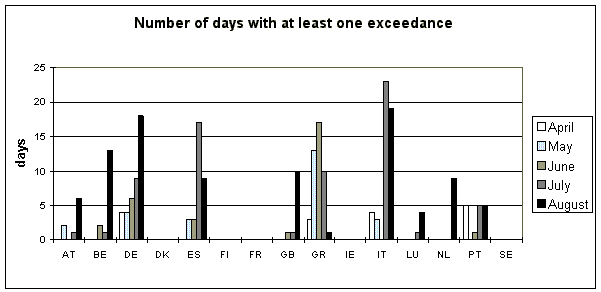
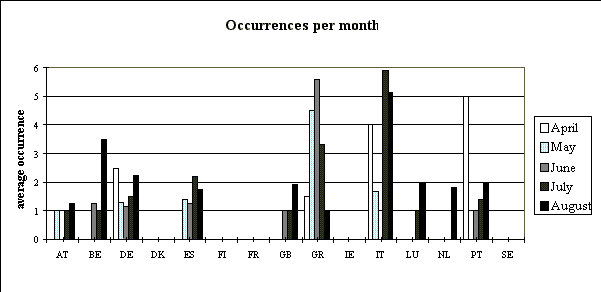
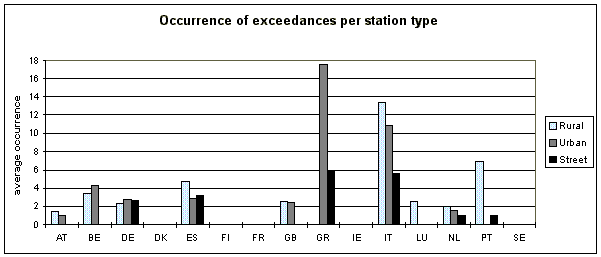
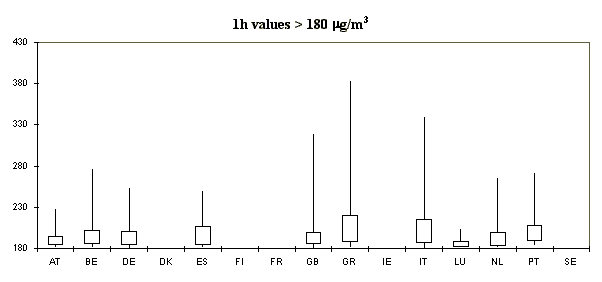
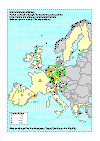
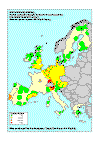
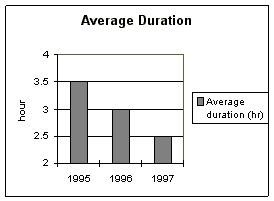
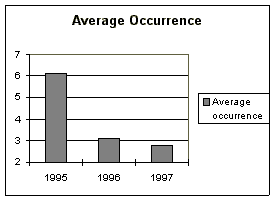
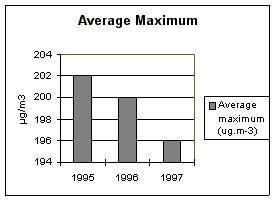
Document Actions
Share with others